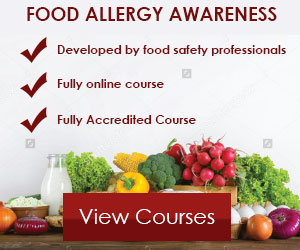Ever heard of Salmonella infection? There’s a good chance of hearing about it as a home cook or restaurant owner, but the big question is, “how much do you know about it?”
If you’re still trying to figure out exactly what it is, its symptoms and how to prevent it, this post for you!
Let’s get to it.
What is Salmonella?
Salmonella infection is a common food-borne bacterial disease that affects the intestinal tract. The disease is typically spread via contaminated food or water — in essence; a person is likely to get infected after eating such foods.
Salmonella is a general name given to an entire family of bacteria that consist of over 2,300 unique stereotypes.
It’s important to note that people with salmonella infection may not manifest any symptom — this is pretty normal. However, there are those who are likely to develop fever, diarrhoea, and abdominal cramps within 8 to 72 hours. Moreover, there’s a good chance of recovering without specific treatment especially if you’re healthy. In essence, healthy people are likely to get better without hospitalisation.
Some cases of salmonella can take a toll on one’s health, and this is especially true for diarrhoea associated with salmonella infection. For the most part, diarrhoea can turn out to be extremely dehydrating and may require quick medical attention. In addition, an infected person may develop life-threatening complications if it spreads beyond the intestines.
Note: People are at higher risk of contracting salmonella if they travel to countries with poor sanitation.
Causes of Salmonella
Salmonella bacteria is primarily transmitted via the consumption of foods that have been contaminated by feces. Such foods include raw meat, poultry, seafood, raw eggs, fruits, and vegetables.
Here are some things to keep in mind
- For starters, raw meat and poultry may get contaminated by feces during the butchering process. There’s also a high chance of getting infected when you consume seafood that came from contaminated water.
- A person may also get infected after eating raw eggs regardless of how protective the shell may be. The thing is, eggs produced by infected chickens can get contaminated by salmonella — this typically happens before the shell is formed.
- Fruits and vegetables that have been watered with contaminated water can also increase the risk of infection. Moreover, cross-contamination can lead to salmonella infection, and this happens when juices from raw meat or poultry touch spinach or salads.
Good to Know
Some cases of salmonella have been traced to contaminants in spices. You should also know that foods can get contaminated when cooked by people who fail to practice good food hygiene. For example, the risk of salmonella infection is higher when you fail to wash your hands after using the bathroom.
What Are the Symptoms of Salmonella Infection?
As we mentioned earlier, salmonella infection comes as a result of eating raw meat, poultry or eggs. Some signs and symptoms to look out for Include vomiting, nausea, diarrhea, abdominal cramps, fever, chills, blood in stool and headache.
These symptoms usually last two to seven days; however, diarrhea may last up to ten days.
What Factors Increase Your Risk of Contracting Salmonella?
There are certain risk factors that increase your susceptibility to salmonella bacteria, and it’s critical to be aware of them. Here are some factors to keep in mind:
Bowel Disorders
The very first you should know is that the body has lots of natural defenses against salmonella infection. However, there are certain medical conditions and drugs that can cut down the effects of these natural defenses.
For example, inflammatory bowel disease damages the lining of your intestines, thus increasing your susceptibility to the infection.
Moreover, the use of antacids will only give strength to more salmonella bacteria. Why? Well, it’s only because stomach acid can kill many types of salmonella bacteria, but antacids lower the acidity. It’s also important to note that antibiotics can reduce the number of good bacteria in your intestine and this may weaken your ability to fight off the infection.
Increased Exposure
The variety of salmonella infection that causes typhoid fever is more common in countries with poor sanitation.
Moreover, some birds and reptiles can be carriers of the bacteria, as such, coming in contact with them will only increase your risk of contracting salmonella infection.
Health Issues and Medications
There are some medical issues and medications that increase your susceptibility to salmonella. This typically happens when your immune system has been weakened by them. They include AIDS, malaria, sickle cell disease, corticosteroids as well as anti-rejection pills.
Are There Complications?
- For starters, some people who get this infection may experience pain in their joints, and this can last for several months or even longer. This condition is typically known as reactive arthritis. It’s important to note that this joint pain could cause painful urination and eye irritation.
- Failure to replace lost body fluids as a result of consistent diarrhoea may lead to dehydration. Some signs include poor urine output, sunken eyes, dry mouth and tongue and reduced production of tears.
- There are several health complications that come as a result of bacteremia, that’s when the infection gets into your blood. bacteremia can infect various body tissues including:
- The lining of your heart or heart valves
- The tissues around your brain and spinal cord
- Bones or bone marrow
- The lining of the blood vessels
Preventive Measures
There are quite a few preventive methods that can save you from salmonella infection, and the good thing is, they’re super easy to follow!
For starters, it’s critical to wash your hands thoroughly after using the toilet, touching raw meat or poultry, changing a diaper and coming in contact with birds or reptiles. The bottom line; always wash your hands — this is good practice.
Follow the 4C’s of food hygiene.
You can also prevent cross-contamination by using a separate cutting board for raw meat and vegetables — it would be great if you can get one for each. Also, be sure to keep raw meat, poultry, and seafood far from other foods in the fridge. Always remember to wash plates that previously held raw meat before placing cooked food in them.
And finally, never eat raw eggs!
And that’s it!
Now you can keep your home and restaurant safe from salmonella.
Here’s to good health!





























